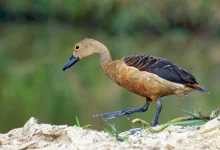The Differences Between Ducks and Geese: An In-Depth Analysis
Ducks and geese are two types of waterfowl that belong to the family Anatidae. While they share some similarities, such as their habitats and dietary preferences, they also exhibit distinct differences in terms of physical characteristics, behavior, habitat, and uses by humans. Understanding these differences is crucial for bird enthusiasts, farmers, and anyone interested in wildlife.
Taxonomy and Classification
Both ducks and geese belong to the same family, Anatidae, which is divided into several genera. Ducks are primarily classified under the genera Anas (e.g., mallards) and Cairina (e.g., muscovy ducks), whereas geese are categorized under the genera Anser (e.g., grey geese) and Branta (e.g., Canada geese).
Taxonomically, ducks are generally smaller and more diverse, while geese are larger and tend to have fewer species. There are about 120 species of ducks and around 30 species of geese, indicating a significant diversity within the duck category.
Physical Characteristics
One of the most apparent differences between ducks and geese is their size and physical appearance. Ducks are typically smaller, with many species weighing between 1 to 3 pounds, while geese are larger, often weighing between 5 to 20 pounds. Geese also tend to have longer necks and larger bodies compared to ducks.
In terms of plumage, both birds exhibit sexual dimorphism, meaning males and females have different appearances. Male ducks, known as drakes, are often more colorful than females, especially during the breeding season. Female ducks typically possess more muted colors, which provide camouflage while nesting. Geese, on the other hand, tend to have a more uniform appearance, with males and females looking similar in plumage, primarily gray or brown with distinctive markings such as a white cheek patch in some species.
Behavior and Social Structure
Ducks and geese also exhibit notable differences in behavior and social structure. Ducks are often more solitary and less social than geese, which tend to form tight-knit family groups and mate for life. Geese are known for their strong familial bonds, often raising their young in cohesive family units. This social structure is crucial for their survival, as the adult geese protect their goslings from predators and teach them essential survival skills.
In contrast, ducks may be seen foraging alone or in small groups. Their mating behavior is less committed than that of geese, with many species engaging in short-term pair bonds during the breeding season. After nesting, many ducks abandon their young, which are precocial and able to feed themselves shortly after hatching.
Habitat Preferences
Both ducks and geese inhabit similar ecosystems, including freshwater lakes, rivers, marshes, and coastal regions. However, they tend to prefer different types of habitats within these ecosystems. Ducks are often found in smaller water bodies, such as ponds and marshes, where they can forage for aquatic plants and insects. Some species, like the mallard, are also commonly found in urban environments, adapting well to human presence.
Geese, on the other hand, prefer larger bodies of water and are often found in open fields and grasslands where they can graze on grasses and grains. They require more extensive habitats for nesting and raising their young. Geese typically nest on the ground in grassy areas near water, while ducks often prefer to nest in dense vegetation.
Diet and Feeding Habits
Both ducks and geese are primarily herbivorous, but their dietary preferences differ. Ducks are omnivorous and consume a wider variety of foods, including aquatic plants, insects, small fish, and crustaceans. Their feeding behavior varies among species; some dabbling ducks feed on the water’s surface or tip their bodies to reach underwater plants, while diving ducks submerge completely to forage.
Geese are primarily grazers, focusing on grasses, sedges, and other terrestrial vegetation. They often feed in fields and meadows, using their strong bills to uproot grass and other plants. Their foraging behavior is characterized by their ability to consume large quantities of vegetation, making them important for managing grassland ecosystems.
Reproduction and Lifespan
The reproductive strategies of ducks and geese also differ significantly. Ducks typically lay between 5 to 15 eggs per clutch, depending on the species, and have a short incubation period of about 28 days. After hatching, ducklings are precocial and can leave the nest within a few hours. They are capable of swimming and foraging for food almost immediately, although they still rely on maternal protection for safety.
Geese, conversely, usually lay fewer eggs, ranging from 2 to 8 per clutch, but they invest more time and effort into raising their young. The incubation period for goose eggs is longer, typically lasting around 30 days. Goslings are also precocial but remain with their parents for several months, learning essential survival skills and social behaviors. The bond between goslings and their parents is strong, and they often stay with their family groups for up to a year.
Economic Importance
Ducks and geese hold significant economic importance in agriculture and aquaculture. Ducks are raised for their meat, eggs, and down feathers, while geese are primarily raised for their meat and feathers. The culinary uses of duck and goose vary; duck meat is often considered a delicacy, known for its rich flavor, while goose meat is less commonly consumed but valued for its unique taste.
In addition to their agricultural uses, ducks and geese play important roles in ecological systems. They contribute to the health of wetland ecosystems by grazing on vegetation, which helps maintain plant diversity and prevents overgrowth. Their droppings also provide essential nutrients for aquatic plants and other organisms, supporting biodiversity.
Conclusion
In summary, while ducks and geese share many similarities as members of the Anatidae family, they are distinct in various aspects, including their size, physical characteristics, behavior, habitat preferences, diet, reproduction, and economic significance. Understanding these differences is essential for appreciating the ecological roles they play and for managing their populations effectively. Both ducks and geese contribute significantly to our natural and agricultural environments, making them vital components of our ecosystems.




